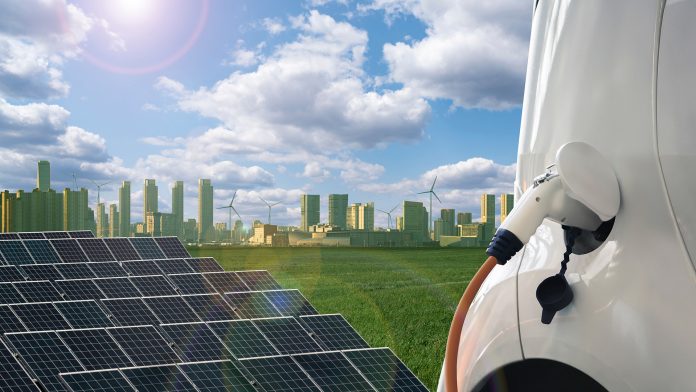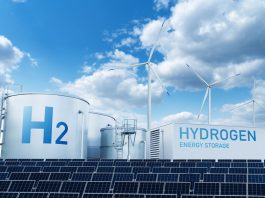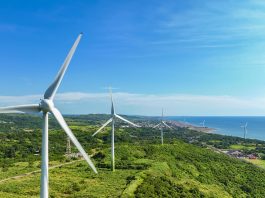The U.S. Department of Energy is prioritising industrial decarbonisation, backed by funding to develop technologies that cut emissions. To find out more, The Innovation Platform spoke to Dr Avi Shultz, Director of the Industrial Efficiency and Decarbonization Office.
The journey toward industrial decarbonisation is both a critical challenge and a formidable opportunity for innovation. As the U.S. Department of Energy (DOE) seeks to lead this transformation, it is imperative to understand the strategies and technologies being developed to reduce greenhouse gas emissions across key industrial sectors.
With recent funding inflows from the Inflation Reduction Act and the Bipartisan Infrastructure Law, the DOE is poised to accelerate advancements in near-term technologies aimed at addressing the substantial emissions produced by energy-intensive industries.
To explore the DOE’s commitment to fostering technological innovation and collaboration, The Innovation Platform spoke to Dr Avi Shultz, Director of the Industrial Efficiency and Decarbonization Office, at the U.S. Department of Energy on how to ensure a sustainable future that aligns with the ambitious goal of achieving a net-zero economy by 2050.
How is the DOE working to accelerate industrial decarbonisation? What are its key focuses in this area at present?
Industrial decarbonisation poses a significant challenge that requires a coordinated effort across the U.S. Department of Energy (DOE). Recent authorities and funding from the Inflation Reduction Act and the Bipartisan Infrastructure Law have invigorated our initiatives to demonstrate near-term technologies aimed at reducing industrial greenhouse gas emissions.
Unlike sectors such as electricity and transportation, where viable solutions are largely developed and commercially available, the industrial sector faces a notable gap in technological advancement. Comprehensive analyses show that while we can effectively target about 40% of emissions from this sector with existing, cost-effective technologies, significant innovation and development are still necessary to address the remaining emissions comprehensively. Our focus must now be on supporting this technological growth to enable broader decarbonisation efforts within the industrial landscape.
Currently, at least 60% of emissions come from sectors where we lack cost-effective technologies for implementation. This is where the Industrial Efficiency and Decarbonization Office comes into play. The Office is dedicated to developing these technologies in an economically viable and rapidly deployable manner, with the goal of achieving a fully net-zero economy by 2050.
The DOE recently announced an investment of over $43m to support the development of cross-sector technologies to drive decarbonisation. Can you elaborate on this and explain why it is so important?
The Office addresses technology development needs for industrial decarbonisation through two complementary strategies, both within our office and in collaboration with other DOE offices.
The first strategy emphasises sector-specific innovation, targeting high-emission industries such as chemicals, iron and steel, cement and concrete, food and beverage, and pulp and paper manufacturing. Our goal is to foster the development of sustainable technologies that enable these energy- and emissions-intensive sectors to achieve comprehensive decarbonisation. Since these industries account for approximately 65% of emissions in the U.S. industrial sector, addressing their specific challenges is critical. However, this is only part of the overall solution.
Complementing this, we also prioritise the development of cross-sector technologies. This initiative focuses on common challenges shared across all industrial sectors, aiming to create solutions that can be tailored to meet the unique needs of specific industries. These strategies include advancements in process heating technologies, energy efficiency improvements, and the use of low-carbon fuels.
In this funding opportunity, we highlighted three specific areas of focus. The first area is the electrification of industrial heating. While we are making significant progress in decarbonising the grid, most industrial process heating – accounting for nearly half of all emissions – still relies on the on-site combustion of fossil fuels. Our objective is to develop electrified heating technologies that eliminate this on-site combustion, enabling a transition to electricity, which can be decarbonised more rapidly.
We also seek to reduce the total energy required to produce the same amount of manufactured products in industrial facilities. For this funding opportunity, we have identified two key areas with substantial potential for energy reduction.
First, we aim to optimise the performance of heat exchangers. As mentioned, nearly 50% of emissions stem from process heating, with significant thermal energy circulated within these environments. Enhancing the efficiency and lowering the costs of heat exchangers, we can significantly minimise the thermal waste associated with these processes, thereby reducing the overall energy consumption of the facilities.
Secondly, we are focused on the development of new membrane separation technologies. Traditionally, the separation of chemical products is carried out through distillation, which requires heating a mixture to take advantage of the different boiling points of its components. This process is notably energy-intensive, especially in the chemicals sector, but it also affects other industries.
Many processes involve drying and dewatering, which are also very energy-intensive. For instance, the removal of water from pulp in a paper mill typically involves boiling the water away, requiring a considerable amount of energy for heating.
By pushing mixtures through a membrane that allows only one component to pass, we can effectively separate components. For example, in a pulp mill, water can pass through the membrane while the pulp remains on the other side. However, the process is more complicated than simply separating the water in a pulp mill, as the liquid involved is highly corrosive, necessitating significant innovation to develop suitable membrane materials and optimise system designs for maximum efficiency.
Additionally, we are focusing on another crucial cross-cutting technology opportunity for industrial facilities: the treatment of wastewater and wet waste.
Wastewater treatment is a significant source of greenhouse gas emissions, primarily due to the energy required for purification processes. Recently, municipal wastewater treatment plants have been rebranded as Water Resource Recovery Facilities (WRRFs). This name change highlights the potential to reduce energy consumption in treatment and recover valuable resources present in wastewater.
Among these resources are those related to energy. If left untreated, wastewater releases considerable greenhouse gases during purification. Organic waste in the water generates methane and other greenhouse gases, particularly nitrous oxide, arising from nitrogen inputs in municipal and agricultural wastewater. Nitrous oxide is especially potent in terms of its greenhouse gas effects.
Our primary focus is on developing technologies that can lower the energy requirements of these facilities while also capturing and converting both energy-dense and potent greenhouse gases into useful products. For example, we aim to convert these gases into renewable natural gas, which can be used to power the treatment facility itself or other industrial operations. Additionally, we are exploring energy-efficient strategies to minimise the release of further greenhouse gases from waste streams.
Can you explain more about the projects that this funding will support?
In the first area of focus, the electrification of industrial heat, we are particularly excited about a project involving thermal energy storage. The Office is funding a California-based startup called RONDO Energy, which has developed this technology.
Industrial facilities typically operate around the clock to maximise the efficiency of their high-capital equipment. However, operations often follow worker shift schedules, usually from 9:00 am to 5:00 pm or during other defined shifts. These limitations in operational flexibility can create challenges when trying to align with renewable electricity sources such as wind and solar, which are inherently intermittent. While nuclear power plants can supply continuous energy, they may not always meet the specific needs of every industrial facility.
Matching low-carbon electricity to industrial facility demands is challenging. This is where thermal energy storage becomes essential. Although batteries are an option for energy storage, they often come at a high cost. We believe that using heat storage technologies, such as those developed by RONDO, which involve heating bricks or solid materials, offers a more economical solution.
This method allows us to decouple the generation of clean electricity from its consumption. The high-temperature bricks created by RONDO can efficiently store energy and release it on demand to industrial facilities. We consider thermal energy storage to be a crucial strategy and are eager to see the innovations RONDO will implement in their upcoming project with us.
Additionally, we are enthusiastic about another innovative project led by Worcester Polytechnic Institute in Massachusetts. Their labs have developed a capability to test new electrified process heating technologies at a subscale, applicable to various drying processes, particularly in the food and paper industries. With prior funding from our office, they will conduct tests and enhance the facility’s capabilities. Their focus will be on integrating lasers and ultrasonic heating technologies to assess their effectiveness in these industrial processes.
Georgia Tech has also developed exciting innovations that could significantly improve the manufacturability of graphene oxide membranes while reducing energy consumption in separation processes. This project focuses on efficient energy use in membranes, particularly for pulp and paper systems, where corrosive liquids must be separated from end products. They are advancing a promising technology that employs graphene oxide, a material well-regarded within the scientific community, and several companies are actively working to commercialise membranes based on it.
Moreover, in the realm of decarbonising wastewater treatment and managing wet organic waste, we are collaborating with the city of Philadelphia. Since many water treatment facilities are operated by municipalities, we are working closely with the Philadelphia Water Department to develop a process known as autothermal pyrolysis. This method effectively converts biosolids from wastewater streams – specifically the organic waste present – into valuable products.
We are in the process of creating a new reactor system in partnership with various universities and an engineering firm. This innovative system aims to significantly increase the extraction of biosolids from wastewater, ultimately transforming them into useful products, particularly fertilisers.
One key advantage of implementing the autothermal pyrolysis process in waste treatment is its potential to significantly decrease sludge production at wastewater treatment plants. Sludge presents substantial challenges in terms of logistics and energy efficiency. It is typically voluminous and has a high water content, making the drying process energy-intensive and disposal cumbersome.
Currently, many wastewater facilities rely on inefficient methods to manage sludge. However, the innovative technology being developed and demonstrated in Philadelphia could reduce sludge volumes by approximately 85%. This substantial reduction would not only decrease the energy needed for drying but also mitigate the logistical difficulties associated with its removal. In essence, we believe this development offers a mutually beneficial outcome in terms of cost-effectiveness for water resource recovery facilities and improved energy utilisation.
Additionally, during our announcement, we unveiled new initiatives stemming from EPIXC, our Manufacturing USA Institute led by Arizona State University. EPIXC, which stands for Electrified Processes for Industry Without Carbon, is a multi-organisational institute spearheaded by Arizona State, with strong partnerships among industry, academia, national labs, and workforce training organisations.
How does this funding fit within the US’ overall decarbonisation goals?
The industrial sector is responsible for approximately 30% of energy-related greenhouse gas emissions. When we factor in non-energy-related emissions, such as those generated during cement production – where carbon dioxide is produced as part of the manufacturing process – this figure rises to nearly 38% of the total greenhouse gas emissions in the US. This significant percentage highlights the critical need to address these emissions.
It is essential to recognise that this is not a fixed target. The industrial sector is expected to grow, and without intervention, emissions could increase by about 30% by 2050. This estimate does not even account for the recent surge in industrial activity in the US, driven by promising manufacturing opportunities arising from the current administration.
This situation underscores the magnitude of the challenge we face. As Secretary of Energy Jennifer Granholm often notes, the industrial sector produces vital products that we rely on, yet it does so with emissions that we cannot ignore.
Our goal is to confront the challenges of decarbonising industry while maintaining the competitiveness of US businesses. It is important to stress that our approach to decarbonisation does not entail deindustrialisation; rather, we aim to stimulate growth within the industrial sector. Our focus is on fostering the innovative technologies and strategies needed for US industries to succeed.
As the global energy transition unfolds, we are witnessing the emergence of new markets and a growing consumer demand for decarbonised products. By promoting these decarbonised technologies, we can enhance the competitiveness of US industry in both domestic and international markets while reducing emissions.
Recent commitments from companies like Ford and Volvo to source decarbonised steel and aluminium for their supply chains highlight this potential. We are excited about the opportunities this creates for US industry to thrive in the global marketplace.
Why are R&D and innovation so important when it comes to decarbonisation?
Our analysis, along with similar studies conducted by various organisations, shows that the industrial sector has historically received the least attention in terms of emissions reduction.
The Department of Energy (DOE) is committed to changing this. We have launched a $6bn demonstration programme, funded by recent US legislation, which the Office of Clean Energy Demonstrations is overseeing. This programme aims to accelerate the introduction of near-term technological solutions for decarbonising industry.
The Office of Industrial Efficiency and Decarbonization was established alongside the industrial decarbonisation roadmap, which outlines the key technologies we believe are essential for achieving a decarbonised future.
Currently, we are focused on a new vision study, ‘Pathways to A U.S. Industrial Transformation: Unlocking American Innovation.’ In May of this year, we held a workshop and issued a request for information based on a draft analysis we published.
The forthcoming report incorporates critical input we collected from stakeholders across the industrial sector during the workshop and through the request for information. It charts a course toward a full industrial transformation and provides frameworks to help the industry make important decisions about when and how to pursue technology pathways to achieve full decarbonisation. The goal of our pathways study is to identify the technological options available for achieving full decarbonisation across various industrial subsectors.
We are excited to share the results of this report soon and engage in constructive discussions with industry stakeholders about how to enable various pathways toward a fully decarbonised industrial sector.
Please note, this article will also appear in the 20th edition of our quarterly publication.









